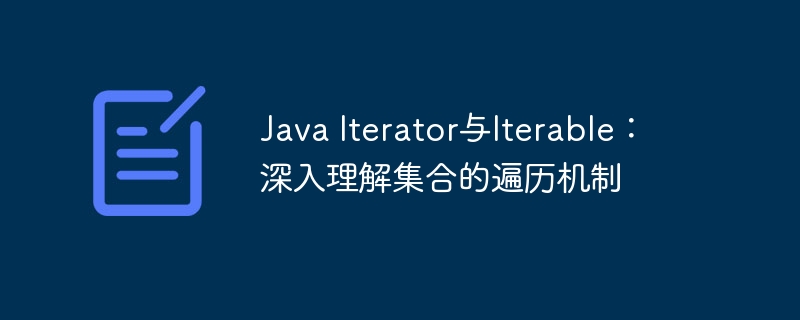 Java
Java
 javaTutorial
javaTutorial
 Java Iterator and Iterable: In-depth understanding of the traversal mechanism of collections
Java Iterator and Iterable: In-depth understanding of the traversal mechanism of collections
Java Iterator and Iterable: In-depth understanding of the traversal mechanism of collections

Java Iterator and Iterable: In-depth understanding of the traversal mechanism of collections In Java programming, collection traversal is a very common operation. In order to better understand the traversal mechanism of collections, we need to delve into the Iterator and Iterable interfaces in Java. This article will start with the definition, function and usage of these two interfaces, and lead you to gradually explore the principles and usage techniques of Java collection traversal. Let us learn in depth with PHP editor Strawberry and master the essence of Java collection traversal!
- Iterator interface: The Iterator interface defines the following methods:
- hasNext(): Returns a Boolean value indicating whether there are more elements in the collection.
- next(): Returns the next element in the collection. If there are no more elements in the collection, a NoSuchElementException exception is thrown.
- remove(): Delete the current element in the collection.
- Iterable interface: The Iterable interface defines an iteration method:
- iterator(): Returns an Iterator object for traversing the collection.
- Use Iterator and Iterable to traverse collections: Here are some examples of using Iterator and Iterable to iterate over collections:
// 使用Iterator遍历集合
List<Integer> list = new ArrayList<>();
Iterator<Integer> iterator = list.iterator();
while (iterator.hasNext()) {
Integer element = iterator.next();
// 对元素进行处理
}
// 使用foreach循环遍历集合
List<Integer> list = new ArrayList<>();
for (Integer element : list) {
// 对元素进行处理
}- The difference between Iterator and Iterable: Iterator and Iterable are two different interfaces. Their main differences are:
- Iterator is a concrete class that provides methods for traversing collections.
- Iterable is a marker interface that represents a collection that can be iterated.
- When to use Iterator and Iterable: In practical applications, we can choose to use Iterator or Iterable according to the specific situation. Generally speaking, if we need fine-grained control over a collection, such as deleting elements or getting the index of the current element, we can use an Iterator. If we just need to iterate through the collection and process each element, we can use Iterable and foreach loop.
In short, Iterator and Iterable are two important components in the Java collection framework. They provide us with the basic mechanism for traversing collections. By understanding the principles and usage of these two interfaces, we can process collection data more efficiently.
The above is the detailed content of Java Iterator and Iterable: In-depth understanding of the traversal mechanism of collections. For more information, please follow other related articles on the PHP Chinese website!

Hot AI Tools

Undresser.AI Undress
AI-powered app for creating realistic nude photos

AI Clothes Remover
Online AI tool for removing clothes from photos.

Undress AI Tool
Undress images for free

Clothoff.io
AI clothes remover

AI Hentai Generator
Generate AI Hentai for free.

Hot Article

Hot Tools

Notepad++7.3.1
Easy-to-use and free code editor

SublimeText3 Chinese version
Chinese version, very easy to use

Zend Studio 13.0.1
Powerful PHP integrated development environment

Dreamweaver CS6
Visual web development tools

SublimeText3 Mac version
God-level code editing software (SublimeText3)

Hot Topics
 Square Root in Java
Aug 30, 2024 pm 04:26 PM
Square Root in Java
Aug 30, 2024 pm 04:26 PM
Guide to Square Root in Java. Here we discuss how Square Root works in Java with example and its code implementation respectively.
 Perfect Number in Java
Aug 30, 2024 pm 04:28 PM
Perfect Number in Java
Aug 30, 2024 pm 04:28 PM
Guide to Perfect Number in Java. Here we discuss the Definition, How to check Perfect number in Java?, examples with code implementation.
 Random Number Generator in Java
Aug 30, 2024 pm 04:27 PM
Random Number Generator in Java
Aug 30, 2024 pm 04:27 PM
Guide to Random Number Generator in Java. Here we discuss Functions in Java with examples and two different Generators with ther examples.
 Weka in Java
Aug 30, 2024 pm 04:28 PM
Weka in Java
Aug 30, 2024 pm 04:28 PM
Guide to Weka in Java. Here we discuss the Introduction, how to use weka java, the type of platform, and advantages with examples.
 Armstrong Number in Java
Aug 30, 2024 pm 04:26 PM
Armstrong Number in Java
Aug 30, 2024 pm 04:26 PM
Guide to the Armstrong Number in Java. Here we discuss an introduction to Armstrong's number in java along with some of the code.
 Smith Number in Java
Aug 30, 2024 pm 04:28 PM
Smith Number in Java
Aug 30, 2024 pm 04:28 PM
Guide to Smith Number in Java. Here we discuss the Definition, How to check smith number in Java? example with code implementation.
 Java Spring Interview Questions
Aug 30, 2024 pm 04:29 PM
Java Spring Interview Questions
Aug 30, 2024 pm 04:29 PM
In this article, we have kept the most asked Java Spring Interview Questions with their detailed answers. So that you can crack the interview.
 Break or return from Java 8 stream forEach?
Feb 07, 2025 pm 12:09 PM
Break or return from Java 8 stream forEach?
Feb 07, 2025 pm 12:09 PM
Java 8 introduces the Stream API, providing a powerful and expressive way to process data collections. However, a common question when using Stream is: How to break or return from a forEach operation? Traditional loops allow for early interruption or return, but Stream's forEach method does not directly support this method. This article will explain the reasons and explore alternative methods for implementing premature termination in Stream processing systems. Further reading: Java Stream API improvements Understand Stream forEach The forEach method is a terminal operation that performs one operation on each element in the Stream. Its design intention is





